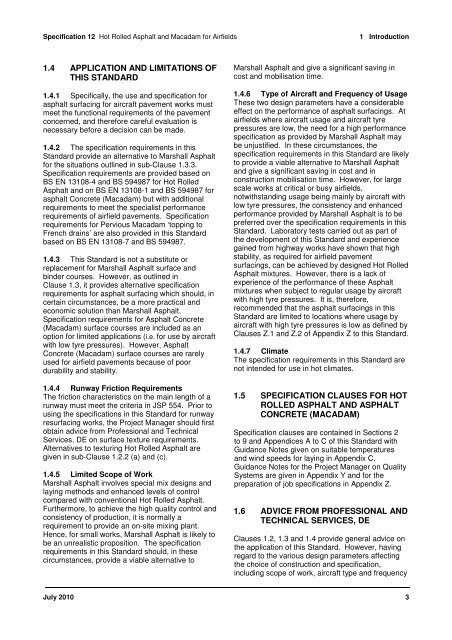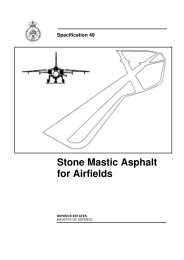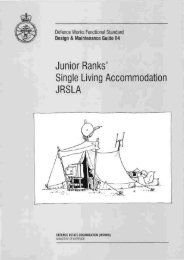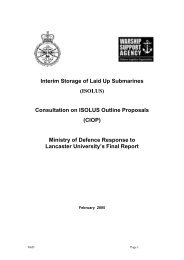Hot Rolled Asphalt and Asphalt Concrete (Macadam) - Ministry of ...
Hot Rolled Asphalt and Asphalt Concrete (Macadam) - Ministry of ...
Hot Rolled Asphalt and Asphalt Concrete (Macadam) - Ministry of ...
Create successful ePaper yourself
Turn your PDF publications into a flip-book with our unique Google optimized e-Paper software.
Specification 12 <strong>Hot</strong> <strong>Rolled</strong> <strong>Asphalt</strong> <strong>and</strong> <strong>Macadam</strong> for Airfields 1 Introduction<br />
1.4 APPLICATION AND LIMITATIONS OF<br />
THIS STANDARD<br />
1.4.1 Specifically, the use <strong>and</strong> specification for<br />
asphalt surfacing for aircraft pavement works must<br />
meet the functional requirements <strong>of</strong> the pavement<br />
concerned, <strong>and</strong> therefore careful evaluation is<br />
necessary before a decision can be made.<br />
1.4.2 The specification requirements in this<br />
St<strong>and</strong>ard provide an alternative to Marshall <strong>Asphalt</strong><br />
for the situations outlined in sub-Clause 1.3.3.<br />
Specification requirements are provided based on<br />
BS EN 13108-4 <strong>and</strong> BS 594987 for <strong>Hot</strong> <strong>Rolled</strong><br />
<strong>Asphalt</strong> <strong>and</strong> on BS EN 13108-1 <strong>and</strong> BS 594987 for<br />
asphalt <strong>Concrete</strong> (<strong>Macadam</strong>) but with additional<br />
requirements to meet the specialist performance<br />
requirements <strong>of</strong> airfield pavements. Specification<br />
requirements for Pervious <strong>Macadam</strong> ‘topping to<br />
French drains’ are also provided in this St<strong>and</strong>ard<br />
based on BS EN 13108-7 <strong>and</strong> BS 594987.<br />
1.4.3 This St<strong>and</strong>ard is not a substitute or<br />
replacement for Marshall <strong>Asphalt</strong> surface <strong>and</strong><br />
binder courses. However, as outlined in<br />
Clause 1.3, it provides alternative specification<br />
requirements for asphalt surfacing which should, in<br />
certain circumstances, be a more practical <strong>and</strong><br />
economic solution than Marshall <strong>Asphalt</strong>.<br />
Specification requirements for <strong>Asphalt</strong> <strong>Concrete</strong><br />
(<strong>Macadam</strong>) surface courses are included as an<br />
option for limited applications (i.e. for use by aircraft<br />
with low tyre pressures). However, <strong>Asphalt</strong><br />
<strong>Concrete</strong> (<strong>Macadam</strong>) surface courses are rarely<br />
used for airfield pavements because <strong>of</strong> poor<br />
durability <strong>and</strong> stability.<br />
1.4.4 Runway Friction Requirements<br />
The friction characteristics on the main length <strong>of</strong> a<br />
runway must meet the criteria in JSP 554. Prior to<br />
using the specifications in this St<strong>and</strong>ard for runway<br />
resurfacing works, the Project Manager should first<br />
obtain advice from Pr<strong>of</strong>essional <strong>and</strong> Technical<br />
Services, DE on surface texture requirements.<br />
Alternatives to texturing <strong>Hot</strong> <strong>Rolled</strong> <strong>Asphalt</strong> are<br />
given in sub-Clause 1.2.2 (a) <strong>and</strong> (c).<br />
1.4.5 Limited Scope <strong>of</strong> Work<br />
Marshall <strong>Asphalt</strong> involves special mix designs <strong>and</strong><br />
laying methods <strong>and</strong> enhanced levels <strong>of</strong> control<br />
compared with conventional <strong>Hot</strong> <strong>Rolled</strong> <strong>Asphalt</strong>.<br />
Furthermore, to achieve the high quality control <strong>and</strong><br />
consistency <strong>of</strong> production, it is normally a<br />
requirement to provide an on-site mixing plant.<br />
Hence, for small works, Marshall <strong>Asphalt</strong> is likely to<br />
be an unrealistic proposition. The specification<br />
requirements in this St<strong>and</strong>ard should, in these<br />
circumstances, provide a viable alternative to<br />
Marshall <strong>Asphalt</strong> <strong>and</strong> give a significant saving in<br />
cost <strong>and</strong> mobilisation time.<br />
1.4.6 Type <strong>of</strong> Aircraft <strong>and</strong> Frequency <strong>of</strong> Usage<br />
These two design parameters have a considerable<br />
effect on the performance <strong>of</strong> asphalt surfacings. At<br />
airfields where aircraft usage <strong>and</strong> aircraft tyre<br />
pressures are low, the need for a high performance<br />
specification as provided by Marshall <strong>Asphalt</strong> may<br />
be unjustified. In these circumstances, the<br />
specification requirements in this St<strong>and</strong>ard are likely<br />
to provide a viable alternative to Marshall <strong>Asphalt</strong><br />
<strong>and</strong> give a significant saving in cost <strong>and</strong> in<br />
construction mobilisation time. However, for large<br />
scale works at critical or busy airfields,<br />
notwithst<strong>and</strong>ing usage being mainly by aircraft with<br />
low tyre pressures, the consistency <strong>and</strong> enhanced<br />
performance provided by Marshall <strong>Asphalt</strong> is to be<br />
preferred over the specification requirements in this<br />
St<strong>and</strong>ard. Laboratory tests carried out as part <strong>of</strong><br />
the development <strong>of</strong> this St<strong>and</strong>ard <strong>and</strong> experience<br />
gained from highway works have shown that high<br />
stability, as required for airfield pavement<br />
surfacings, can be achieved by designed <strong>Hot</strong> <strong>Rolled</strong><br />
<strong>Asphalt</strong> mixtures. However, there is a lack <strong>of</strong><br />
experience <strong>of</strong> the performance <strong>of</strong> these <strong>Asphalt</strong><br />
mixtures when subject to regular usage by aircraft<br />
with high tyre pressures. It is, therefore,<br />
recommended that the asphalt surfacings in this<br />
St<strong>and</strong>ard are limited to locations where usage by<br />
aircraft with high tyre pressures is low as defined by<br />
Clauses Z.1 <strong>and</strong> Z.2 <strong>of</strong> Appendix Z to this St<strong>and</strong>ard.<br />
1.4.7 Climate<br />
The specification requirements in this St<strong>and</strong>ard are<br />
not intended for use in hot climates.<br />
1.5 SPECIFICATION CLAUSES FOR HOT<br />
ROLLED ASPHALT AND ASPHALT<br />
CONCRETE (MACADAM)<br />
Specification clauses are contained in Sections 2<br />
to 9 <strong>and</strong> Appendices A to C <strong>of</strong> this St<strong>and</strong>ard with<br />
Guidance Notes given on suitable temperatures<br />
<strong>and</strong> wind speeds for laying in Appendix C.<br />
Guidance Notes for the Project Manager on Quality<br />
Systems are given in Appendix Y <strong>and</strong> for the<br />
preparation <strong>of</strong> job specifications in Appendix Z.<br />
1.6 ADVICE FROM PROFESSIONAL AND<br />
TECHNICAL SERVICES, DE<br />
Clauses 1.2, 1.3 <strong>and</strong> 1.4 provide general advice on<br />
the application <strong>of</strong> this St<strong>and</strong>ard. However, having<br />
regard to the various design parameters affecting<br />
the choice <strong>of</strong> construction <strong>and</strong> specification,<br />
including scope <strong>of</strong> work, aircraft type <strong>and</strong> frequency<br />
July 2010 3









